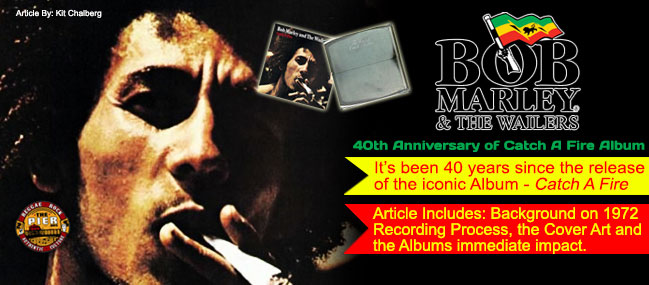
Bob Marley & The Wailers: 40th Anniversary of Catch A Fire Album
Bob Marley & The Wailers –“Catch A Fire”
 (Original) Track List:
(Original) Track List:
Side one:
1. “Concrete Jungle” – 4:13
2. “Slave Driver” – 2:53
3. “400 Years”(Peter Tosh) – 2:45
4. “Stop That Train” (Tosh) – 3:55
5. “Baby We’ve Got a Date (Rock It Baby)” – 3:57
Side two:
6. “Stir It Up” – 5:32
7. “Kinky Reggae” – 3:37
8. “No More Trouble” – 3:57
9. “Midnight Ravers” – 5:10
Release Date: April 13th, 1973
Record Label: Island Records
April 13, 2013 marked a milestone in music history. The date celebrated the 40th Anniversary of the release of Bob Marley and the Wailers’ legendary album, “Catch A Fire.” The Wailers fifth and first release on Island Records, the album featured songs like “Stop That Train,” “Concrete Jungle” and “Stir It Up.”
“Catch A Fire,” which is slang for “getting into trouble,” garnered critical acclaim and was the beginning of the Wailers international success. Rolling Stone Magazine called “Catch A Fire” one of the greatest reggae albums of all time, ranking it 126 of the 500 greatest albums of all time—the second highest placement of the five Marley albums on the magazine’s list.
Recording Catch A Fire…
The story behind “Catch A Fire” is a complicated one. It is full of financial struggles, legal issues and the exchange of publishing rights. By the early 1970’s, Marley had secured a contract with Johnny Nash’s label, CBS Records. In 1972 the Wailers were in London promoting the Nash-produced single, “Reggae On Broadway.” However, CBS had little faith in the band and abruptly abandoned them in Great Britain—opting for the sunny beaches of Miami instead. Permit issues left the Jamaicans unable to work, ultimately forcing the band to ask their promoter, Brent Clarke, for help. Brent then contacted Island Records, who agreed to advance the Wailers funds to return to Jamaica and record the album.

The recording of “Catch A Fire” began in 1972. The sessions were held at three Kingston studios including, Dynamic Sound, Harry J’s and Randy’s. A handful of the final recordings on “Catch A Fire” included songs that were changed from earlier recording sessions.
“Some of the songs had been recorded before… in different studios and with different musicians, but we gave them that strict timing and brought the feeling out of them more,” says bassist, Aston “Family Man” Barrett. Most notably, the album’s first single “Baby, We’ve Got A Date,” was similar to the song “Black Bitter,” which was recorded in an earlier session.
After completing the album, Marley flew back to London in the winter of 1972 to present the master tapes to Island Records founder, Chris Blackwell. Unfortunately, since the band was already under contract with CBS and Sims, the record deal with Island created a legal dispute. When a settlement was reached, CBS received $9,000 and two percent of royalties from the band’s first four albums. In addition, Sims received the publishing rights to the Wailers songs and $7,000. Following the settlement, the album was officially released on Island Record’s Blue Mountain subsidiary in 1973.
Leaving an Impression…
Jason Draper, author of “A Brief History of Album Covers,” says Blackwell had big plans for the band’s major label debut. By 1972, Jamaica’s top reggae star, Jimmy Cliff, had left the label and Blackwell saw Marley as the ideal artist to attract an audience primed for rock music.
“I was dealing with rock music, which was really rebel music and I felt that would really be the way to break Jamaican music. But you needed someone who could be that image. When Bob walked in he really was that image,” Blackwell once reflected. Marley and the Wailers delivered “Catch A Fire” to serious international fanfare, bringing reggae rebel music to the masses.
 For the album’s cover, Blackwell enlisted the help of Rod Dyer and Bob Weiner to design the album’s original cover, which was designed to look like a Zippo lighter. The sleeve opened up like a clapperboard, with a hinge on the side keeping both halves of the cover together. The record sat in the bottom pouch so that, when you opened the sleeve, you could see the top of it poking out like the flint on a proper Zippo.
For the album’s cover, Blackwell enlisted the help of Rod Dyer and Bob Weiner to design the album’s original cover, which was designed to look like a Zippo lighter. The sleeve opened up like a clapperboard, with a hinge on the side keeping both halves of the cover together. The record sat in the bottom pouch so that, when you opened the sleeve, you could see the top of it poking out like the flint on a proper Zippo.
Although it was an innovative idea, the album’s functional design proved difficult to manufacture because of the lack of technology that could properly fix the halves together. As a result, each sleeve had to be handmade, causing serious production issues. In the end, the first 20,000 copies used the innovative design, while every copy following used the cover we know today.
The album’s release and subsequent supporting tour changed Marley’s life forever and forged a road to international success and recognition. In England they performed at universities and clubs, and to the country’s audience via BBC. In the U.S. the Wailers performed three times in New York City alongside an unknown songwriter named Bruce Springsteen. They also opened for peaking artists Sly and the Family Stone, but were rumored to have been removed after just four dates because their riveting performances had upstaged the headliner.
It is a given that Bob Marley and the Wailers are music legends. Forty years ago they added to that legacy with the release of “Catch A Fire”—an album that has stood the test of time, influenced countless across the world and propelled Marley to fame. Marley, the Barrett Brothers, Bunny Wailer, Peter Tosh and the entire band overcame a series of hurdles to record and release the album.
Luckily for the Wailers and the entire music community “Catch A Fire” emerged from the turmoil—ultimately paving the way for mainstream success and etching a place in music history.
How Did Catch A Fire Impact Your Life or Music!?Facebook / Twitter
Bob Marley & The Wailers Links:
Bob Marley Website
The Wailers Website
Bob Marley Facebook
The Wailers Editorials
Article By: Kit Chalberg
Watch: Classic Albums: Bob Marley & The Wailers – “Catch A Fire” documentary
Listen: Bob Marley & The Wailers – “Concrete Jungle” live

